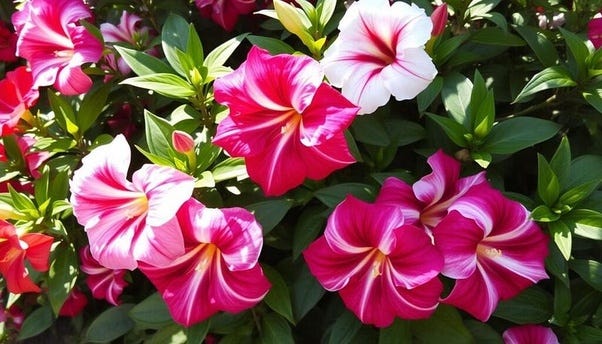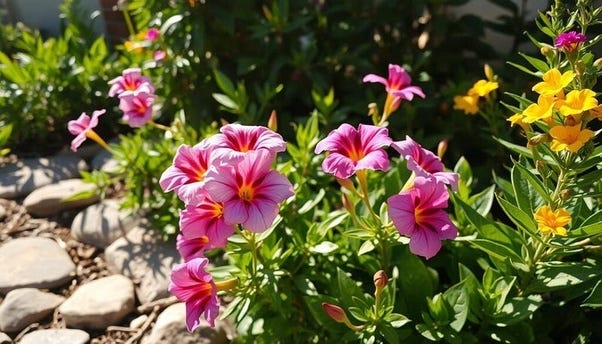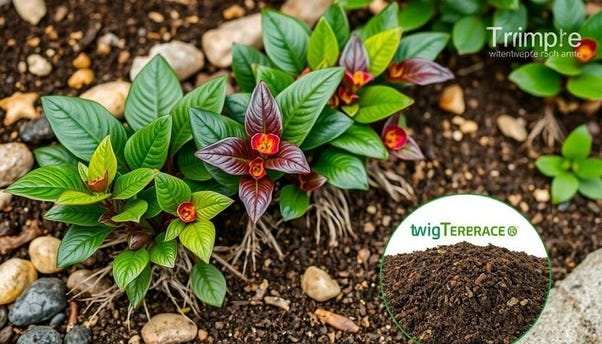Dipladenia: Care Guide for Vibrant and Healthy Growth
Ever thought about turning your garden into a tropical paradise? Dipladenia, a beautiful climber from the Apocynaceae family, could be your answer. This plant, from the tropics of Brazil, has flowers shaped like trumpets in white, red, pink, and coral. It blooms for a long time and draws in pollinators, making it a great choice for gardeners.
Caring for dipladenia is pretty easy, but knowing what it needs is key. These plants do best in USDA Hardiness Zones 10–11, liking full to partial sun and soil that drains well. The soil should be acidic to neutral in pH. For the best growth, keep temperatures between 65 and 85 degrees Fahrenheit during the day, and a bit cooler at night.
To keep dipladenia plants happy, make sure they get enough water but don’t drown them. Let the top few inches of soil dry out before watering again. Feed your dipladenia every three to four weeks with a balanced plant food during the growing season. Pruning it regularly keeps it looking neat and encourages new growth, keeping your garden or indoor spot looking great.
Introduction to Dipladenia
Dipladenia is a beautiful tropical plant that belongs to the Apocynaceae family and Mandevilla genus. It comes from the warm forests of South America. People love it for its bright colors and easy care.
Native Habitat and Characteristics
Dipladenia plants grow well in USDA hardiness zones 9 through . They can live outside all year. They grow 1–2 feet tall and spread about 2 feet wide. Their shiny, dark green leaves and tubular flowers bloom from March to November.
Popularity Among Gardeners
Gardeners like dipladenia for its long blooming season and easy care. It’s great for both new and seasoned gardeners. It likes soil with a pH of 6.6 to 7.8 and full sun.
Dipladenia vs. Mandevilla
Dipladenia and mandevilla are often mixed up, but they’re different. Dipladenia grows bushier, has smaller flowers, and leaves that are heart-shaped. Mandevilla is vining and can grow up to 15 feet tall. Both have various flower colors, including red, white, pink, yellow, and apricot.
Popular dipladenia types include Sun Parasols®, in many colors, and the yellow Summer Romance (Diamantina®). These Diamantina® types handle cooler temperatures well and bloom early. They’re a hit with gardeners in many climates.
Understanding Dipladenia Plant Types
Dipladenia plants come in many varieties, each with its own growth habits and beautiful flower colors. Let’s dive into the world of these lovely plants. We’ll see why they’re so popular among gardeners.
Common Varieties
There are over 100 species of Dipladenia, giving gardeners lots of choices. The Sundenia series is a hit, with compact evergreen shrubs that grow to 2′ x 2′. They have large 3–5″ flowers that bloom all summer. You can find white dipladenia like ‘Sundenia White’ with crisp white flowers, or red ones like ‘Sundenia Red’ with bright red blooms.
Growth Habits and Sizes
Dipladenia grows like a shrub, perfect for filling in baskets or containers. It doesn’t need support like its relative Mandevilla. It loves full sun, needing at least 6 hours of sunlight a day to bloom well.

Flower Colors and Shapes
Dipladenia flowers come in colors from pure white to bright red, with yellow varieties adding a sunny feel to gardens. Their flowers are trumpet-shaped and smaller than Mandevilla’s. To keep them blooming, make sure they get consistent moisture with good drainage. Feed them water-soluble fertilizer every couple of weeks.
To make dipladenia plants bloom well, they need the right conditions. They love warm temperatures and lots of sunlight. For the best blooms, they should get at least 4 hours of direct sunlight each day.
When taking care of dipladenia plants, think about how much light they need. They do great in full sun, making them ideal for sunny spots in gardens or on bright patios. If you’re keeping them indoors, put them near a south-facing window for enough light.
Watering your dipladenia plants right is key. Water them when the top 2 inches of soil feel dry. These plants have tubers that store water, helping them get through short dry spells. For new plants, watering every day for a few weeks helps roots grow strong.
Dipladenias do well in soil that drains well. Plant them 8″ to 12″ apart to let them grow properly. These plants fit well in many places, doing great in containers and gardens. They can handle different climates, from dry to humid.
For the best care, keep dipladenias in temperatures between 65–85°F during the day. If it gets colder than 45°F, bring them inside for the winter. This keeps your plants alive and blooming year after year.
Sunlight Requirements
Understanding what dipladenia needs in terms of sunlight is key for their growth. These plants love bright conditions, making them great for sunny spots in gardens and on patios.
Full Sun Exposure
Dipladenia plants do best in full sun, needing 4 to 6 hours of direct sunlight every day for lots of blooms. This sunlight helps them flower well, giving you lots of colorful flowers. When planting them outside, put them in a spot that gets lots of morning or afternoon sun.
Partial Shade Tolerance
Even though dipladenias like full sun, they can handle some shade, especially in hot places. Too much sun can cause sunburn and stress. If your plant has crispy leaves, burned edges, or fading colors, it might be getting too much sun. To protect your dipladenia, use sheer curtains or shade cloth during the hottest part of the day.
Indoor Light Considerations
For dipladenias inside, they need bright, indirect light. East or west-facing windows are perfect, giving them enough light without burning them. If there’s not enough natural light, add grow lights for 12 to 14 hours a day to mimic the sun. In winter, keep your dipladenia on a sunny windowsill, making sure it stays above 45°F.

Dipladenias can grow 12″ to 24″ tall and attract butterflies and hummingbirds with their bright flowers. With the right amount of light, you’ll get a beautiful display of flowers all season.
Soil and Potting Needs

Dipladenia loves soil that drains well and is full of organic matter. For the best growth, use a mix that holds moisture but doesn’t get too wet. The best soil for dipladenia has a pH between 6.6 and 7.8, helping it get the nutrients it needs.
When planting dipladenia, pick a top-quality mix or make your own. A good DIY mix is one part potting soil, one part perlite, and one part coarse sand. This mix is great for drainage and air around the roots, which is key for healthy roots.
For container gardens, use a pot with good drainage holes. Fill it with your chosen mix, leaving some space for watering. The soil should break apart easily when you squeeze it, like a good coffee cake.
Don’t forget to move your dipladenia to fresh soil every year. This keeps the soil full of nutrients and stops it from getting too dense. It helps your dipladenia grow strong and bloom well all season.
“Proper soil and potting practices are the foundation for stunning dipladenia displays.”
Give your dipladenia the right soil, and it will thrive. These plants draw in butterflies and hummingbirds, making your garden lively. With proper care, your dipladenia will give you beautiful flowers and greenery every year.
Watering Guidelines for Dipladenia
Knowing how much water your dipladenia needs is key to keeping it healthy. Proper watering helps your plant bloom well and grow strong all year.
Frequency and Amount
Check the soil by feeling the top 1 to 2 inches. If it’s dry, it’s time to water. In summer, water your dipladenia every week. In winter, you can go two weeks without watering. New plants need water every day for the first few weeks to grow strong roots.

Seasonal Adjustments
Change how often you water with the seasons. Water more in summer to help it grow and bloom well. This is because it gets hotter and dries out the soil faster. In winter, cut back on watering to stop root rot — only water when the soil is dry about an inch deep.



Comments
Post a Comment